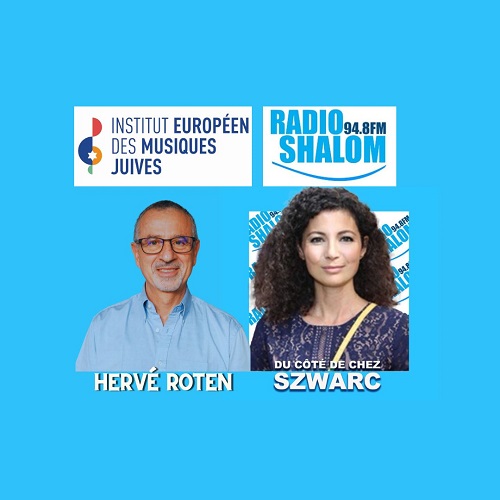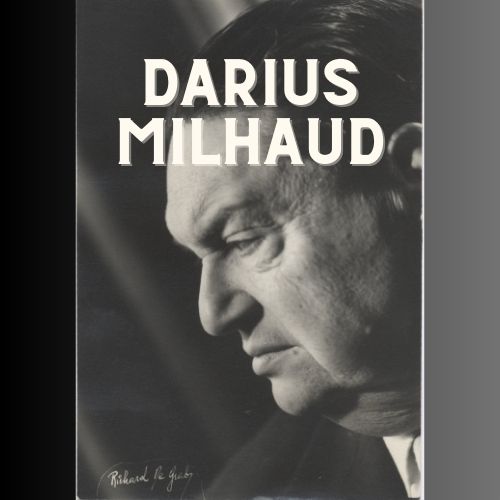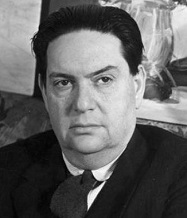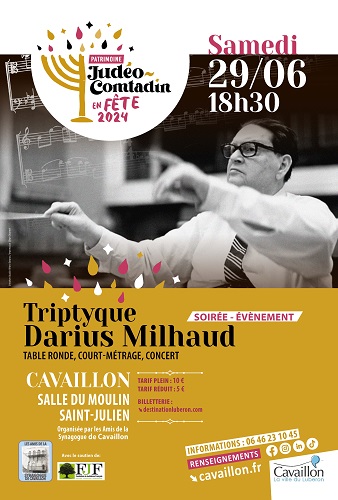
Hervé Roten – Proceedings of the 19th Congress of the AIBM – July 2001
The origins of the Jewish community in France are very old. It was in the year 6 A.D. that Archelaus, Ethnarch of Judea, banished by the Roman Emperor Augustus, settled in the town of Vienne (Isère). Under the Merovingian kings, Jewish families took up residence in the Frankish territories. During the following centuries, these groups, generally small, developed or disappeared according to the vicissitudes of history.
At the dawn of the French Revolution, the Jewish community numbered around 40,000 members, mainly established in Alsace-Lorraine, the Comtat Venaissin and in the South-West of France. With the emancipation, French Judaism was enriched throughout the 19th century with people from Central Europe and, in particular, Germany. In 1880, the pogroms in Russia led to the emigration of Polish, Romanian and Russian Jews to France. From 1908 onwards, Jews from the Ottoman countries (especially from Salonika, Constantinople and Smyrna) passed through France and sometimes settled there. Between the two wars, several successive waves brought more than 100,000 Jews from Italy, Central and Eastern Europe (Germany, Austria, Hungary, Czechoslovakia, Russia, Poland, Ukraine, Latvia, Lithuania…), to which were added Sephardic Jews from Greece and Turkey.
After the Second World War, the Jewish community in France was greatly weakened. The Rabbinate was decimated and the disaffection with religious practices was complete. It was not until the arrival of nearly 200,000 Jews from North Africa between 1956 and 1967 that French Judaism began a religious and cultural revival.
Today, French Judaism is particularly composite. Estimated at between 600,000 and 700,000 people, it constitutes a real mosaic of communities with varied traditions and origins.
I. Jewish music in France: an overview
Jewish musical traditions in France reflect the multicultural dimension
of Judaism. From synagogal chant to Yiddish folklore, from oriental dances to Eastern European klezmer music, an uninformed spectator will be somewhat disarmed by the heterogeneity of the musical practices. However, they can be divided into two genres: religious music for internal use and secular music that draws on the sources of ethnicity.
1) Religious music
Liturgical music represents the essence of Jewish musical practice. Singing is omnipresent in the synagogue or at home and gives rhythm to the life of the faithful. Every religious Jew goes to the synagogue three times a day to recite the tunes learned from his fathers according to the oral tradition. The Jewish festivals give rise to a more or less pronounced musical flourish depending on their significance and importance within the liturgical calendar.
The cantors take on the vocal parts of the service alongside the rabbi. The congregation responds by singing different parts of the prayers. Among these congregants, the importance of the Ba’ale massore [1]Textually: possessor of the tradition should be noted. This scholar, who knows the tradition by memory, is the guarantor of the correct observance of the rites and the tunes sung in his synagogue. It should be noted that these traditions, originally essentially oral and monodic, have since the 19th century included a polyphonic repertoire for choir, sometimes accompanied by the organ, despite the ban on musical instruments in the synagogue since the fall of the Temple (70 A.D.) [2]The only notable exception is the shofar, a ram’s horn blown during the festivals of the New Year (Rosh Hashana) and the Day of Atonement (Yom Kippur).
Each synagogue has its own musical rite, which depends on the practice of age-old traditions and the origin of the majority of the faithful. Thus in a homogeneous community, composed exclusively of Tunisian Jews, the prayers will be sung according to the Tunisian rite. In the large Parisian synagogue on rue de la Victoire, the Ashkenazi rite, which originated in the Consistory period, differs from a Polish or Russian Ashkenazi rite for example. Some communities – especially in cities where the Jewish population is small – have congregations from very different backgrounds, and there is a mixture of tunes and traditions depending on the impact and strength of the groups involved.
2) Secular music
Outside of worship, there is a community musical practice of a secular nature. Music is experienced as a marker of identity, which bears witness to a flourishing culture that is now disappearing. Thus, the Ashkenazim revive the haunting melodies of Yiddish folklore; the Chasidim dance and express their joy to the sound of klezmer orchestras evoking the ancient instrumental ensembles of Eastern Europe; and the ancient Judeo-Spanish romances or lullabies retrace the history of the kingdom of Solomon.
These artistic practices usually take place in community centres, festival halls, concert halls or even in the café-theatre. Singing is the predominant element, but dancing, which perpetuates Chasidic or Israeli folklore, plays a significant role. To accompany the singers or dancers, instruments such as the violin, clarinet, accordion, guitar and various types of percussion are frequently used. Often the various performers of this music are not specialised in a single tradition. They do not hesitate to appropriate easily interchangeable repertoires, linking Yiddish songs and Judeo-Spanish music. In this way, they draw from a vast musical reservoir, born of the tribulations of the Jewish people, to create a kind of mythical and stylised folklore.
Another novelty factor is that in recent decades Israeli folk songs and dances [3]such as the Horah, a dance originating in Romania have been incorporated into the repertoire of Jewish musical traditions. This popular music is usually performed within youth movements or during major family celebrations, such as weddings, religious initiation (Bar mitsvah), or even circumcision.
This brief overview highlights the liveliness and great diversity of Jewish musical traditions in France. Through contact with the surrounding civilisations, Jewish music has absorbed many exogenous stylistic elements: thus ancient biblical cantillations rub shoulders with medieval Andalusian poetry, Eastern European airs and 19th century lyrical compositions. In this respect, Jewish music is a land of fossils, made up of musical layers from different times and places, a living musical memory of humanity that urgently needs to be collected and studied before it disappears as a result of the socio-demographic upheavals of the 20th century (Shoah, intercultural marriages, assimilation and the growing influence of Israeli culture).
In order to respond to this need, the Fondation du Judaïsme Français developed the idea of a research programme devoted to the musical heritage of French Jews.
II. The Musical Heritage of the Jews of France programme
The Musical Heritage of the Jews of France programme is structured around four major axes:
– 1) to list the various participants in the field of Jewish music (rabbinical bodies, connoisseurs of traditions, musical associations, musicians, etc.) in order to compile a guide and directory of Jewish musical traditions in France,
– 2) to make an inventory of the music archives and to help safeguard them,
– 3) to collect a set of oral or written documents that are particularly representative of the diversity of Jewish musical traditions in France,
– 4) to promote this heritage by organising events (concerts, conferences, symposiums) and by distributing a collection of records devoted to the musical heritage of the Jews of France (original recordings or digitisation of unpublished musical archives).
Part of the data collected in the framework of the research programme Musical Heritage of the Jews of France will be available on a website. Conceived as an opening onto Jewish musical practices in France, this site will endeavour to follow Jewish musical news (calendar of events, biographical notes on musicians, extracts from the latest discographic publications, etc.) and to make the link with other resource centres in the field of Jewish music (cf. the site map in Appendix 1).
In the long term, one of the objectives will be to make available to the general public a sound and visual “showcase” of Jewish musical creations and traditions in France through the ages.
III. Jewish music archives: elements of an inventory
The inventory of places where Jewish music is practiced, preserved and disseminated started about a year ago. It is therefore too early to give significant results. At the very most, it is possible to provide some elements of the inventory carried out in Paris and its region where about two thirds of the 600 to 700,000 Jews in France are located.
The first part of my work consisted in contacting institutions or associations likely to house documents with a Jewish musical content. I have deliberately postponed the inventory of archives belonging to private collectors; their access is not easy and will have to be approached individually. As the Jewish community is relatively well institutionalised, I was able to quickly enter into contact with the leaders of various Jewish institutions. Once I had explained the purpose of my approach, my interlocutors were generally willing to cooperate fully by opening the doors of their collections to me.
On the spot, there were two scenarios: either the collections were inventoried and duly catalogued, or – more often – vaguely archived in boxes or, worse still, left to decay in a sometimes advanced state. In the second case, I had to make a summary inventory myself, which was recorded in a notebook until it could be entered in a computer database currently being set up. My first objective was to locate the main sources of Jewish music, to draw up a summary inventory without taking the place of the cataloguing work which remains the responsibility of the institutions that own the collections.
Documentation sites and main results of the inventory :
– Archives of the Central Consistory of France
17 rue Saint Georges – 75009 Paris (Contact : Philippe Landau)
Rich collection but in a very poor state of conservation. No existing inventory.
Description of the fund :
• 13 collections of scores (from 1895 to 1953) of cantorial music for solo or accompanied voice.
• 10 archive boxes, most of which are marked “Jewish music of the 19th century – Samuel David”. In reality, boxes 1, 2, 3, 6, 7, 8 and 9 contain mainly the manuscripts (orchestra and separate parts) of the works of Samuel David, Director of Music at the Consistory in the last third of the 19th century. Samuel David was also a composer of opera music, operettas and symphonies. Box 4 contains various printed scores from the beginning of the 20th century as well as letters relating to synagogue music practice. Box 5 contains scores by Salomon Rossi and manuscripts by Samuel David. Finally, box 10 contains the text of Leon Algazi’s radio broadcasts “The Voice of Israel” recorded between 1932 and 1934. Other recordings, probably archived at Radio France, are also mentioned. Box 10 also contains four handwritten transcriptions of cantorial tunes.
– Library of the Alliance Israélite Universelle (A.I.U.)
45 rue la Bruyère – 75009 Paris (Contact : Jean-Claude Kupermink)
Description of the fund :
One of the most important collections on various aspects of Judaism. The purely musical part includes the following items:
• 75 scores of Yiddish songs, a cappella or with instrumental accompaniment (songs, opera arias, operettas, theatre, liturgies; music by Lebedoff, Goldfaden, Small, Sirota, Rosenblatt, etc.) published in the USA between 1897 and 1921.
• 71 collections of various scores (liturgical songs, Yiddish and Judeo-Spanish melodies, etc.).
• 68 background studies (books, articles) on Jewish music.
• The sound collection is almost non-existent (a few discs and cassettes), the bulk of the recordings being deposited in the Yuval collection (see below) which is housed in the same premises as the Alliance Israélite Universelle.
– Library of the Unknown Jewish Martyr Memorial
17 rue Geoffroy l’Asnier – 75004 Paris (Contact : Mme Karen Taieb)
Specific collection (war 1939-1945), very few archives with a musical content: a few books and scores on music in the camps; general works on musicians or composers of Jewish origin (Darius Milhaud, Gustav Mahler…). In the same building on the lower floor, the archives contain two scores of music composed by Jewish musicians in the French detention camps.
– Library of the Museum of Jewish Art and History
Hôtel de St Aignan, 71 rue du Temple – 75003 Paris (Contacts : Isabelle Pleskoff, Alexandre Litvak)
Rich fund, in the process of being built up.
Description of the fund :
• 29 scores of Yiddish music (songs, operas, Goldfaden’s sung theatre, Rumshiski, Small…) for voice, piano or violin, published between 1900 and 1917 in the USA.
• Approximately 120 printed materials with musical content (books, music anthologies, scores).
• No music manuscripts.
• 76 78 RPM discs recorded in the U.S.A., France and Palestine between 1928 and 1950, containing a repertoire of popular Yiddish music (cabaret, comedy…), klezmer music and cantorial music.
• 250 compact discs listed on a database accessible at www.mahj.org/base_cd-audio
• A large part of the musical iconography has been digitised: postcards from the beginning of the 20th century, engravings, paintings, instrumental postcards, engravings, paintings, instrumental plates…
• Music video collection (26): biographies of musicians, documentaries on various Jewish musical traditions.
– National Library
a) Hebrew Manuscripts Department
58 rue de Richelieu – 75003 Paris (Contact : Michel Garel) :
This collection, which is rather limited as far as music is concerned, has been inventoried and listed in the R.I.S.M. (Répertoire International des Sources Musicales) by Israel Adler.
b) Music Department
2 rue de Louvois – 75003 Paris (Contact : Françoise Grange) :
Very important collection of all French publications in the field (legal deposit). The files contain over 350 references to Jewish music.
However, as the old files are not computerised, many records are redundant from one file to another. Nevertheless, the collection as a whole includes nearly 80 collections of scores, some of which were established in the 19th century.
General file: main entries and number of references ()
• Subject catalogue: Jewish music (140), folk songs (4), Jewish folklore (17), Chasidism (7), Israel, History (9), cantillation (18).
• Catalogue Musical Subjects : Jewish (2)
• Catalogue musical material: liturgical, music (84)
File of the Conservatoire Nationale Supérieur de Musique (C.N.S.M.) :
• Jewish music (18), Jewish dictionary (2)
– Library of the Israelite Seminary of France
9 rue Vauquelin – 75005 Paris (Contact : Joël Touati)
Important and unpublished collection, not inventoried to date: approximately 300 items (?). Brief description (the complete inventory will be made later) :
• A large number of collections of early printed scores (last third of the 19th century).
• Many manuscripts.
• Books on music and biblical cantillation.
• Microfilmed musical transcriptions of cantorial tunes.
• Some rare records, no magnetic tape.
– Vladimir Medem Library
52 rue René Boulanger – 75010 Paris (Contact : Blanche Belfer)
This important and high quality collection is essentially devoted to Yiddish culture. It is part of the collections of the Association D’Étude et de Diffusion de la Culture Yiddish (A.E.D.C.Y.).
Description of the fund :
• About 150 collections of Yiddish scores of all kinds (songs, operettas…)
• Archive (1950 to 1970) of the repertoire of the Jewish folk choir.
• Scores of the Jewish choir of the Union des Engagés Volontaires Anciens Combattants Juifs 1939-1945.
• Important sound collection: 200 78 RPM and 300 33 RPM LPs as well as commercial and home-made cassettes.
N.B.: this collection will soon be installed in the brand new House of Yiddish Culture (18, passage Saint-Pierre Amelot Paris – XIe)
– National Museum of Popular Arts and Traditions
6 avenue du Mahatma-Gandi – 75016 Paris
Music and Speech Department (Contact: Florence Getreau)
The collection of Jewish music of the A.T.P. is very limited and does not directly concern our subject. It is essentially due to the musician and ethnomusicologist André Hajdu. Hajdu, a student of Zoltan Kodaly in Hungary, collected and deposited four Judeo-Romanian song tunes in the museum archives. The museum also has in its collections fourteen laments on the theme of the “wandering Jew”, taken from collections of peddlers dating from the end of the 18th and beginning of the 19th centuries.
– Yuval, French Association for the Preservation of Jewish Musical Traditions
45 rue la Bruyère – 75009 Paris (Contacts : Yaffa Ellenberger, David Klein)
Dedicated solely to Jewish music, this collection includes:
• Written section: 130 books, 80 scores, 7 manuscripts, 50 bibliographies of artists.
• Sound section: 120 black discs, 290 audio cassettes (commercial recordings or copies of commercial discs), 150 audio cassettes (ethnic recordings or non-commercial documents), 70 educational cassettes (courses, radio programmes, etc.), 80 compact discs, 20 audio tapes and 10 DATs.
• Audiovisual section: 2 videos.
N.B.: The libraries of the Centre Rachi (75005), the Centre Communautaire (75010), the Jewish Library (75019) and the Moadon Ivri Library (75007), which were also contacted, do not have significant Jewish music collections.
Conclusion :
Although not claiming to be exhaustive, the inventory elements that have just been given provide very positive signs as to the importance of Jewish musical collections in France, both from a quantitative and qualitative point of view.
Given the large number of unknown and often poorly preserved documents, the Musical Heritage of the Jews of France programme of the Fondation du Judaïsme Français appears to be an opportunity to safeguard and make known the diversity of Jewish music in France, as a fully-fledged part of French musical heritage.



